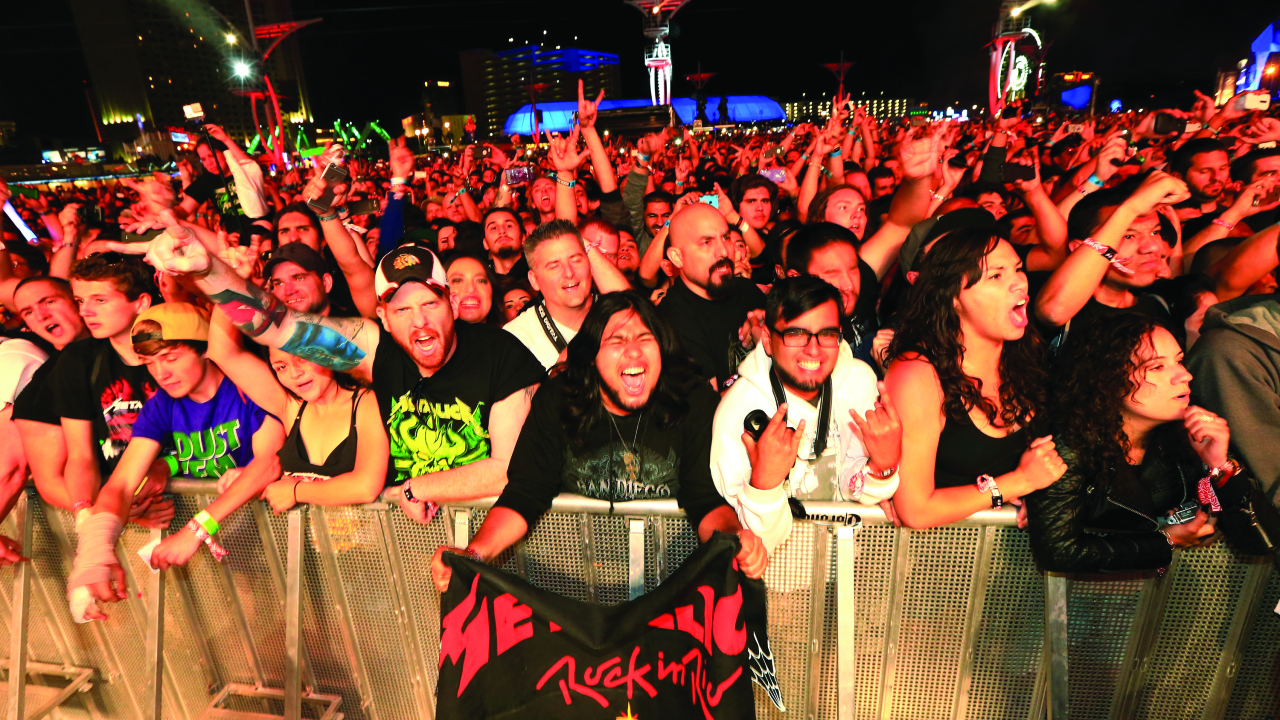For many fans, metal represents much more than just another form of entertainment – it’s a way of life.
The fact that we’re discussing this subject in a long-running magazine dedicated to metal is testament to how much we as a community care about our music. We not only listen to it; we read about it, talk about it, watch videos about it, go to see it live, wear clothes inspired by it and, most of all, identify as metal fans. Just as importantly, metal fans tend to keep on listening to metal. Take a visit to the likes of Wacken or Bloodstock and you’ll see devotees in their second, third, fourth even fifth decade of metal-listening.
Unsurprisingly then, the recent news that music streaming giant Spotify (and their research centre, The Echo Nest) now believes metal to have the most loyal fanbase has been met more with back-slapping and high-fiving than surprise in the metal community. But what does ‘loyalty’ really mean in this context, and what are the implications of this research for us as fans?
The first thing to make clear is that we’re talking about loyalty and not popularity. There aren’t more people listening to Carcass than Kanye on Spotify. What the research actually tells us is that metal fans spend a greater percentage of their time on Spotify listening to metal than, say, jazz fans spend listening to jazz. In other words, metal fans on Spotify mainly listen to metal, rather than jumping from genre to genre. By that measure, metal fans on Spotify are about 40% more loyal than pop, folk, reggae, country, jazz, blues, classical and rap fans. Which is actually pretty significant. So why is that the case?
“Metal isn’t merely a form of music, but an entire series of symbols, ideas, lore and history,” suggests Bernie Hogan, a sociologist and research fellow at the University Of Oxford. “This makes it more a subculture than merely a taste. Thus loyalty is not to a specific band or type of music, but to a cultural identity. As pop music is much more focused on contemporary fashion, and often appealing to a specific youth demographic, it is not as straightforward to build pop as a culture and cultural identity.”
“Metal fans are loyal to their music; they buy CDs still, and they don’t turn their backs,” agrees Chuck Billy of Testament, who has been on the metal frontlines for over 30 years. “Young fans at the Rockstar Mayhem Festival will see Slayer’s headlining and go, ‘OK, I’m going to buy the record and see what it’s about.’”

Both men’s comments point to one of metal’s great strengths: it’s imbued with a profound sense of community and continuity that connects multiple generations of bands and fans. Metal as we know it today has been with us since the 70s and early 80s, and while other movements have come and gone, it has never gone away. Moreover, although metal constantly develops, it also remembers its roots. Look at the godfathers of the genre – Sabbath, Priest, Maiden – these bands are still loved by kids discovering metal for the first time, as well as by people old enough to be their parents or even grandparents.
Arguably, you can’t say the same for a lot of music genres. Dance and pop music shift sound and fanbase frequently. How many young dubstep fans follow 80s electronica? How many teenage, entry-level rap fans do you see when rap legends like Public Enemy or Afrika Bambaataa play? Not too many, especially compared to the number of new metal fans at a Metallica or Slayer show. That’s because in metal culture it’s expected of you that as well as knowing new bands, you’re schooled in the masters – if you’re a death metal fan and you don’t know Cannibal Corpse or a thrasher who hasn’t heard of Megadeth, your peers are likely to bug you until you do.
“Metal is a big family tree,” agrees Mark Palmer, MD of Nuclear Blast and formerly of Roadrunner Records. “All the branches grow out and develop different genres and different bands, so all the bands around now you can trace back to classic metal or rock bands. You can trace Motionless In White back to Alice Cooper, for example, so people want to discover where their favourite artist has come from, and that filters through and creates interest.”
“That aspect is very applicable to metal,” agrees Century Media’s UK Marketing Manager David Gulvin. “There’s a sense that if you don’t know the history, you don’t really know what you’re talking about. The loyalty to older bands is still there – you just have to look at who’s headlining the big festivals.
“However,” he adds, “those bands come from a time of there being only four television stations in the UK whereas a lot of kids now grew up with mobile phones, the internet and all the choices that come with that. Guitar music in general has become more fickle and metal has been eroded by the fragmentation of what is considered to be a metal band.”

That raises a big question: what does Spotify consider metal? After all, if we as a community spend a good deal of our time arguing about what is and isn’t metal, how on earth were Spotify able to decide what counted and what didn’t for their research?
“The Echo Model clusters groups, artists and songs that share common descriptors and similar acoustic and cultural attributes,” explains Eliot Van Buskirk, who analysed the statistics for the report. “It looks for the words people use to describe music on the web and that is checked and balanced by the way it actually sounds – everything from tempo to energy level and whether it’s in major or minor. It’s super-complicated, but out pops about 1,400 different genres of music and a list of 200 ‘core artists’, so it’s not just Metallica and bands of that level. I felt the idea of people returning to the core of the genre was a good way to get to loyalty, because you’re returning to the artists who really define the genre.”
Included in that 200 were artists as varied as (deep breath): Sabaton, Cradle Of Filth, Opeth, In Flames, Amon Amarth, Dark Tranquillity, At The Gates, Metallica, Trivium, Blind Guardian, Lamb Of God, Amorphis, Megadeth, Behemoth, Black Label Society, Hammerfall, Arch Enemy, Iron Maiden, Children Of Bodom, King Diamond, Exodus, Therion and Bolt Thrower. There’s no denying that all these bands are essentially heritage acts in one way or another – in fact, most of them have been around for 20-30 years.

“I’m sure if Spotify picked some more contemporary acts,” says Mark Palmer, “the findings would have been different. Traditional metal realm fans are more loyal than anyone else – there just aren’t as many of them!”
“It would be interesting to do this again,” comments Eliot, “to see if emerging metal bands come up top of the list as well. That might be the sequel – to look at what people don’t listen to. Do jazz fans listen to more other genres because they’re more exploratory listeners, for example?”
This is perhaps the most important thing to consider – metal fans are sticking to core artists, but there’s still a question about their loyalty to newer and more fringe bands. The generational bonds may mean that older bands are enjoyed by all, but it must be remembered that these acts became big in an era before streaming, downloads, YouTube and MP3s. The danger is that young bands and fans exist in a very different culture – one where listeners are overwhelmed with choice and loyalty to bands (and even the concept of being loyal to a whole album) is valued less. Yes, there are encouraging aspects of this research, but for metal as a culture, we should realise that this is no time to be resting on our laurels.
“Compared to the past, the fanbase certainly isn’t as loyal as it was,” concludes Mark Palmer. “Especially younger fans can move from one band to another and one scene to another very easily – you see that with the rise of the more ‘scene bands’, where a lot of their popularity is based on what the lead singer looks like and the hair and tattoos he has. Those kind of bands have real issues because their fans are very fickle and can be gone tomorrow. Even in the metal world, working for Roadrunner, we had bands who had very successful debuts and in earlier times you would have expected them to sell a similar number of records on the second and third albums… now bands can see sales halve from one album to another because those kids have moved on. I think it’s going to be very difficult for a band starting out now to maintain a 15- or 20-year career, simply because the audience that is getting into them in the first place is not going to stick with them as they used to.”
A scary thought indeed. Perhaps as the playing field adapts from a world of record stores to one of streaming and, yes, Spotify, it’s time for the metal scene to start addressing how best to maintain a culture of loyalty so that the potential Priests and Maidens of tomorrow can bring joy to generations of fans in a few decades’ time…
Follow Metal Hammer on Spotify and listen to the New Noise playlist via https://play.spotify.com/user/metalhammer
